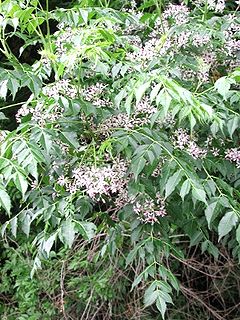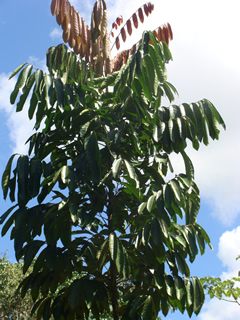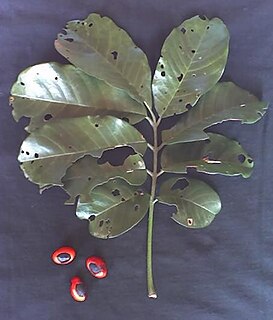
Meliaceae, the mahogany family, is a flowering plant family of mostly trees and shrubs in the order Sapindales.

Cedrela is a genus of several species in the mahogany family, Meliaceae. They are evergreen or dry-season deciduous trees with pinnate leaves, native to the tropical and subtropical New World, from southern Mexico south to northern Argentina.

Carapa is a genus of flowering plants in the mahogany family, Meliaceae. These are trees up to 30 meters tall occurring in tropical South America, Central America, and Africa. Common names include andiroba and crabwood.

The Burseraceae are a moderate-sized family of 17-19 genera and about 540 species of flowering plants. The actual numbers differ according to the time period in which a given source is written describing this family. The Burseraceae are also known as the torchwood family, the frankincense and myrrh family, or simply the incense tree family. The family includes both trees and shrubs, and is native to tropical regions of Africa, Asia. Australasia, and the Americas.

Parkinsonia microphylla, the yellow paloverde, foothill paloverde or little-leaved palo verde; syn. Cercidium microphyllum), is a species of palo verde.
Mutisia microphylla is a species of flowering plant in the family Asteraceae. It is found only in Ecuador. Its natural habitats are subtropical or tropical moist montane forests and subtropical or tropical high-altitude shrubland. It is threatened by habitat loss.
Aerva microphylla is a species of plant in the family Amaranthaceae.

Aglaia argentea is commonly known as Silver Boodyara, Bekak, or Koping-koping. [5] It is a tropical wild grown evergreen native to Australia, throughout East Asia and in several Pacific islands.[6]
Anthocleista microphylla is a species of plant in the family Gentianaceae. It is found in Cameroon, Equatorial Guinea, Ghana, Nigeria, and São Tomé and Príncipe. Its natural habitat is subtropical or tropical moist lowland forests. It is threatened by habitat loss.

Cedrela angustifolia is a species of tree in the mahogany family, Meliaceae. Local common names include cedro de Tucumán, cedro bayo, cedro coya, and cedro del cerro. It is native to South America, where it occurs in Argentina, Bolivia, Brazil, Paraguay, and Peru.

Ruagea is a genus of plants in the family Meliaceae. It contains the following species :
Ruagea microphylla is a species of plant in the family Meliaceae. It is endemic to Ecuador. It has been listed as an endangered species by the International Union for Conservation of Nature (IUCN)

Trichilia is a flowering plant genus in the family Meliaceae. These plants are particularly diverse in sub-Saharan Africa and tropical South America.

Trichilia triacantha, the bariaco, is a species of plant in the Meliaceae family. It is endemic to Puerto Rico. It is threatened by habitat loss. It is a federally listed endangered species of the United States.
Turraeanthus africana is a species of plant in the family Meliaceae, also known by the common names avodiré, apeya, engan, agbe, lusamba, wansenwa, African satinwood, and African white mahogany.

Bursera microphylla, known by the common name elephant tree in English or 'torote' in Spanish, is a tree in genus Bursera. It grows into a distinctive sculptural form, with a thickened, water-storing or caudiciform trunk. It is found in the southwestern United States and northwestern Mexico.

Xylocarpus is a genus of plants in the mahogany family (Meliaceae). It includes two or three species of mangroves, native to coastal mangrove forests of the Western and Central Indo-Pacific, from eastern Africa to Tonga.
Ulmus boissieriGrudz.,, a disputed species of elm found in Iran, was identified by Grudzinskaya in 1977. She equated her "new species" with the U. campestris f. microphylla collected in 1859 in Kerman Province and described in his Flora Orientalis (1879) by Boissier, for whom she named it, treating Boissier's specimen as the "type". The tree is endemic the provinces of Kermanshah and Kerman., and also the Zagros forests, growing with Quercus brantii, Celtis australis, Platanus orientalis, Fraxinus sp., and Cerasus mehaleb.
Michelsonia is a genus of tree in the legume family, Fabaceae, where it is classified in the subfamily Detarioideae. It is a monotypic genus, the only species being Michelsonia microphylla. It is native to the tropical rain forests of the Democratic Republic of the Congo. The wood is used locally for construction work.

The Waterman Mountains are a low mountainous landform in Pima County, United States. Notable among the tree species is the elephant tree which species exhibits a contorted multi-furcate architecture; most of these froze in the cold winter of 2011. The Waterman Mountain range is in the Ironwood Forest National Monument.













